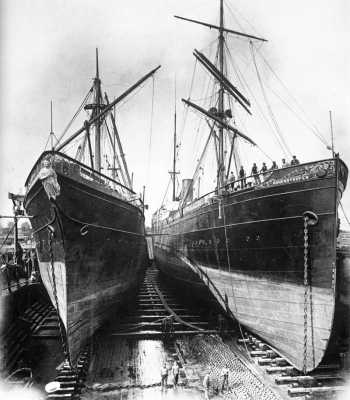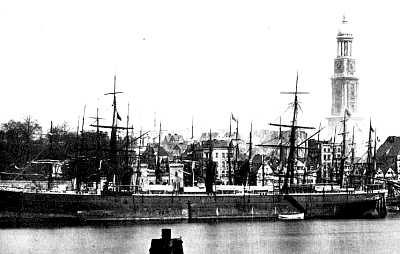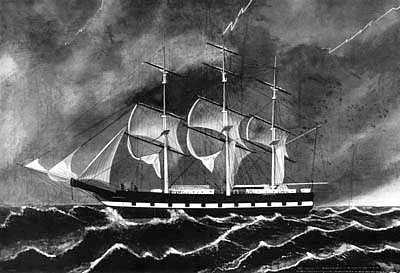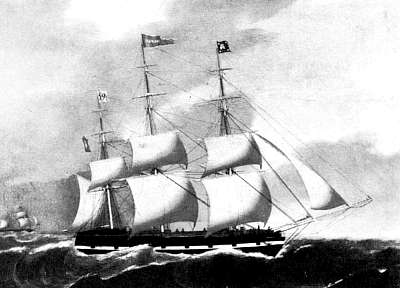Palmer List of Merchant Vessels

|
HOHENSTAUFEN (1873)
Photograph of the Norddeutscher Lloyd steamships WESER
(L) and HOHENSTAUFEN (R) in drydock. Source: Clas Broder Hansen,
Passenger liners from Germany, 1816-1990, translated from the German
by Edward Force (West Chester, Pennsylvania: Schiffer Pub., c1991), p. 31.
To request a larger copy of this scan, click on the picture.
|
The steamship HOHENSTAUFEN was built for Norddeutscher Lloyd
by Earle's Shipbuilding Co, Hull (yard #173), and was launched on 24
September 1873. 3,098 tons; 107,46 x 12,03 meters (length x breadth); straight
stem; 1 funnel, 2 masts; iron construction, screw propulsion, compound
engine; service speed 12 knots; accommodation for 142 passengers in 1st
class and 800 in steerage; crew of 79-100.
The HOHENSTAUFEN was laid up immediately upon completion until
August 1874, due to the depression in the United States, which sharply
curtailed immigration. She was originally intended for the South American
service, but did not enter the service until 1895. 1 September 1874, maiden
voyage, Bremen - Havre - New York. 20 December 1874, last voyage, Bremen -
Southampton - New York (3 roundtrip voyages). 4 April 1880, first voyage,
Bremen - Christiania - New York (2 roundtrip voyages). 24 September 1881,
first voyage, Bremen-South America. 3 September 1884, rammed by the armored
corvette SOPHIE, which tore a hole in her starboard side. 29 April
1885, last voyage, Bremen - New York. 14 April 1886, single roundtrip voyage,
Bremen-Baltimore. 1886, refitted at Bremerhaven for the new Reichspostdienst
to Australia. 26 January 1887, first voyage, Bremen-Suez Canal-Australia.
1890, refitted by AG Vulcan, Stettin: 3,283 tons; triple-expansion engine,
service speed 13 knots; passenger accommodation altered to 44 in 1st class,
18 in 2nd class, and 558 in steerage. 8 May 1895, last voyage, Bremen-Suez
Canal-Australia. 11 February 1897, last voyage, Bremen-South America. 1897,
sold to London for scrapping. January 1898, resold to Brest; scrapped.
Sources: Arnold Kludas, Die Seeschiffe des Norddeutschen
Lloyd, Bd. 1: 1857 bis 1919 (Herford: Koehler, c1991), pp. 24-25
(photograph); Edwin Drechsel, Norddeutscher Lloyd Bremen, 1857-1970; History,
Fleet, Ship Mails, vol. 1 (Vancouver: Cordillera Pub. Co., c1994), 39
(photograph), and 73, no. 42; Noel Reginald Pixell Bonsor, North Atlantic
Seaway; An Illustrated History of the Passenger Services Linking the Old World
with the New (2nd ed.; Jersey, Channel Islands: Brookside Publications),
vol. 2 (1978), p. 550; Noel Reginald Pixell Bonsor, South Atlantic Seaway;
An Illustrated History of the Passenger Lines and Liners from Europe to Brazil,
Uruguay and Argentina (Jersey, Channel Islands: Brookside Publications,
c1983), p. 241.
[11 March 2001]
|
HOLSATIA (1868)
ROSSIJA [1878]
DNESTR [1894]
BLOKSHIF N5 [1910]
Photograph of the HOLSATIA in the Jonashafen, Hamburg,
in the 1870's. Source: Arnold Kludas, Die Geschichte der Deutschen
Passagierschiffahrt, Bd. 1: Die Pionierjahre von 1850 bis 1890, Schriften
des Deutschen Schiffahrtsmuseums, 22 (Hamburg: Kabel, c1986), p. 37. To
request a larger copy of this scan, click on the picture.
|

|
The steamship HOLSATIA was built for the Hamburg-America Line
by Caird & Co, Greenock (yard #143), and was launched on 9 March 1868.
3,134 tons; 103,5 x 12,3 meters (length x breadth); straight stem, 1 funnel,
2 masts; iron construction, screw propulsion, service speed 12 knots;
accommodation for 90 passengers in 1st class, 130 in 2nd class, and 520 in
steerage; crew of 120. Captains: N. Trautmann, 1868; H. Ehlers, 1868-1870;
J. E. Meier, 1870-1872; B. H. A. Barends, 1872-1875; H. F. Schwensen, 1878;
C. L. Brandt, 1878.
10 June 1868, maiden voyage, Hamburg - Southampton - New York. 14 April
1875, last voyage, Hamburg - Havre - New York; laid up. 1877, compound engines.
30 January 1878, resumed Hamburg - Havre - New York service. 20 March 1878,
last voyage, Hamburg - Havre - New York (2 roundtrip voyages). 6 June 1878,
acquired by the Russian Volunteer Fleet and renamed ROSSIJA. November
1894, DNESTR (Russian navy transport and school ship). December 1910,
BLOKSHIF N5 (hulk). October 1916, scuttled at Trebizond, in the Black
Sea.
Sources: Arnold Kludas and Herbert Bischoff, Die Schiffe der
Hamburg-Amerika Linie, Bd. 1. 1847-1906 (Herford: Koehler, 1979), p. 28
(photograph); Walter Kresse, ed., Seeschiffs-Verzeichnis der Hamburger
Reedereien, 1824-1888, Mitteilungen aus dem Museum für Hamburgische
Geschichte, N. F., Bd. 5. (Hamburg: Museum für Hamburgische Geschichte,
1969), vol. 1, p. 191; Noel Reginald Pixell Bonsor, North Atlantic Seaway;
An Illustrated History of the Passenger Services Linking the Old World with
the New (2nd ed.; Jersey, Channel Islands: Brookside Publications), vol.
1 (1975), p. 389.
Voyages:
- Hamburg-America Line steamship HOLSATIA, Capt. Barends, arrived
at New York 20 May 1874 (passenger manifest dated 21 May 1874), from
Hamburg 6 May, via Havre 9 May, with merchandise and 757 passengers.
- Hamburg-America Line steamship HOLSATIA, Capt. Barends, arrived
at New York on 1 July 1874, from Hamburg 17 June and Havre 18 June.
- Hamburg-America Line steamship HOLSATIA, Capt. Barends, arrived
at New York on 19 August 1874, from Hamburg 5 August, via Havre 7 August,
with merchandise and 383 passengers.
[26 May 1999]

|
HOWADJI (1852)
Ship HOWADJI, of Newburyport, struck by lightning
and burning in mid-ocean, 3 November 1857. Oil painting. 26 x 38 in.
Signed: W. J. Crasey, Newburyport.
Peabody Essex Museum, Salem,
Massachusetts, M2924. Gift of an anonymous donor. Source: Marion V. and
Dorothy Brewington, The Marine Paintings and Drawings in the Peabody
Museum (Salem, Massachusetts: Peabody Museum of Salem, 1981), p. 49,
no. 214. To request a larger copy of this scan, click on the picture.
|
The U.S. ship HOWADJI, 695 tons, was built at Newburyport
by John Currier in 1852. The word "howadji" comes from the Arabic for
"merchant; rich (in particular, European) gentleman". The vessel was
owned by William Balch & Son, of Newburyport, and was commanded by
George E. Balch.
Although she made at least one voyage to Antwerp, and was lost on a
voyage from Boston to Liverpool, the HOWADJI appears to have
been engaged primarily in the coastal trade, sailing between New York,
Philadelphia or New England and New Orleans: in 1853 she was advertised
as sailing in the Eagle Line of coastal packets between New York and
New Orleans, and in 1854 as sailing in the Philadelphia & New
Orleans Line of coastal packets between Philadelphia and New Orleans
[Carl C. Cutler, Queens of the Western Ocean; The Story of America's
Mail and Passenger Sailing Lines (Annapolis: United States Naval
Institute, c1961), pp. 519, 541].
On 3 November 1857, on a voyage from Boston to Liverpool, the HOWADJI
was struck by lightning, and burned at sea. The following is an account of her
destruction, taken from the New York Herald, 13 November 1857, p. 8e-f:
DESTRUCTION OF THE SHIP HOWADJI, OF NEWBURYPORT, BY FIRE
--The ship HOWADJI, Capt. George E. Balch, sailed from Boston 30th
ult[imate] for Liverpool, with a cargo of cotton, hemp, oil cake, &.
She was 693 tons burthen. Nothing out of the usual course occurred until
Nov 3, at 5 PM, when the ship was struck by lightning, knocking down the
second mate and several of the men, and setting fire to the ship in the
lower hold. The smell of burning cotton was immediately perceived, and
the hatches were opened, but the locality of the fire could not be
discovered. Finding the smoke issuing freely, the captain closed the
hatches, making all tight, with the purpose of stifling the fire. The
ship was then headed for Sable Island, distant about one hundred miles.
The weather was light, but breeze NW and squally. At 8 1/2 o'clock a
ship was discovered standing to the westward, and finding the fire
progressing fast, the captain deemed it advisable to run for her. Her
attention was attracted by blue lights and rockets, and at 9 1/2
o'clock she was spoken, and the condition of the HOWADJI stated,
with the request that she should keep with the ship, which she did. The
fire, however, progressed fast, and finally she was, by request, hove to
and the crew of the HOWADJI taken on board at 11 PM. The small
boat made half a dozen trips, saving the chronometer and the personal
effects, in part, of all hands. The deck and masts were at this time
very hot, and much smoke was forced out. The captain saw the
impossibility of saving the ship, and reluctantly abandoned her at 2 AM
of the 4th. Immediately on leaving the ship, the flames burst out, and
shortly after the ship went down in about lat 42 50 N, lon 61 40 W, the
mizzenmast standing. The ship GUTTENBURG, Capt Meyers, from
Hamburg bound to New York, was the one that rescued the crew, and
Capt Balch commends his prompt answers to his signals, his keeping
company as requested, and his final hoving to and rescuing himself and
crew. Capt Meyers showed his unfortunate guests every attention and
kindness, and they wish publicly to thank him and his people for their
uniform kindness and good will.
[The HOWADJI was a fine vessel of 700 tons, built at Newburyport in 1852,
and rated A1. She cleared Oct 23 from Boston for Liverpool, loaded with
1299 bales cotton, 500 bales hemp, 1359 bags oil cake, 36 bales rags,
4200 staves, 22 hhds tallow, 10 bbls tallow, 10 bales rags. Value of
cargo estimate, $92,000; freight $9000; vessel $35,00--total loss,
$135,000. She is insured in Boston for $142,000, as follows: Merchants'
office $27,500, Boston $21,000, American $20,000, China $17,000, Boylston
$17,000, National $16,000, Mercantile $8500, Alliance $10,000, Franklin
$5000; New England Mutual $700, and Neptune $400. The H was owned by Wm
Balch & Son, of Newburyport.]
Voyages:
- Ship HOWADJI, of Newburyport, Massachusetts, George E. Balch,
master, arrived at New York on 16 November 1853 (passenger
manifest dated 18 November 1853), from Antwerp 17 September,
and Flushing 8 October, with merchandise and 259 passengers, to
Funch & Meincke. "The H has experienced heavy westerly gales the
entire passage; 17 deaths has [sic] occurred during the passage."
(The fact that the vessel tarried for three weeks at Flushing
suggests that fever may have broken out among the passengers
almost immediately upon departure from Antwerp, but the
contemporary New York newspapers make no mention of this.)
[13 May 1999]
|
HOWARD (1822)
Oil painting by L. Petersen, 1847. 91 x 59 cm. 1968
in the possession of Frau Christina Martens, Nieblum/Föhr. Source:
Ernst Hieke, Rob. M. Sloman Jr., errichtet 1793,
Veröffentlichungen der Wirtschaftsgeschichtlichen
Forschungsstelle e.V., Hamburg, 30 (Hamburg: Verlag Hanseatischer
Merkur, 1968), facing p. 39.
|

|
The U.S., later Hamburg, ship HOWARD, was buil at New York
by Smith & Dimon, in 1822, and first registered at the port of
New York on 29 June 1822. 336 tons; 107 ft x 26 ft 6 in x 13 ft 3 in
(length x beam x depth of hold). From 1823 to 1827, the HOWARD
served in the Second Line of sailing packets between New York and Havre.
During this period her westbound passages averaged 36 days, her
shortest passage being 26 days, her longest 48 days. In 1827 and 1828,
the HOWARD sailed as a packet between New York and Savannah,
her southbound passages averaging 8.4 days, her shortest passage being
6 days, her longest 12 days.
Between mid-1828 and mid-1829, the HOWARD, under the command of
Louis Wiederholt (born 1804), made three voyages between New York and
Hamburg. On 28 May 1829, Wiederholt, who had obtained a certificate of
registry for the HOWARD in New York on 28 August 1828 (the owners
are listed as Petersen & Mench, New York, and Heinrich Küstner,
Leipzig), sold the vessel to the Hamburg firm of Johann Philipp Koch
& Johann Heinrich Schultz. Wiederholt retained command of the
HOWARD through 1830; shortly afterwards he took up command of
the Havre sailing packet ship DE RHAM:
Voyages:
1829/30 - New York/Bremen
1831 - New York
On 11 October 1831, Koch & Schultz sold the HOWARD to Ocke
Hinrich Flor, who had succeeded Wiederholt as master of the vessel early
in 1831, and who retained personal command of her:
Voyages:
1831/32 - New York
1832 - Bremen/New York
1832/33 - New York
1833 - New York
1833/34 - New York
1834 - New York
1834/35 - New York
1835 - New York
1836 - New York (2 x)
1837 - New York (2 x)
1837/38 - New York
1838 - New York
On 7 December 1838, Flor sold the HOWARD to the Hamburg shipowner
Robert Miles Sloman, although he remained master of the vessel until 1840.
Masters:
1838-1840 - Ocke Hinrich Flor (former owner and master)
1840-1845 - Paul Nickels Paulsen
Voyages:
1838/39 - New York
1839 - New York
1839/40 - New York
1840 - New York
1840/41 - New York
1841 - New York (2 x)
1842 - New York (2 x)
1843 - New York (2 x)
1843/44 - New York
1844 - New York
1844/45 - New York
1845 - New York
Sloman sold the HOWARD Norwegian (Capt. Jenssen) in 1845.
Sources: Walter Kresse, ed., Seeschiffs-Verzeichnis
der Hamburger Reedereien, 1824-1888, Mitteilungen aus dem Museum
für Hamburgische Geschichte, N. F., Bd. 5 (Hamburg: Museum
für Hamburgische Geschichte, 1969), vol. 1, pp. 140 and 282;
vol. 2, p. 206; Ernst Hieke, Rob. M. Sloman Jr., errichtet 1793,
Veröffentlichungen der Wirtschaftsgeschichtlichen Forschungsstelle
e.V., Hamburg, Bd. 30 (Hamburg: Verlag Hanseatischer Merkur, 1968), p.
370, no. 10.
[13 Sep 1997; 24 Apr 2000]

|
HOWARD (1846)
CAESAR [1861]
Oil painting by L. Petersen, 184?. Source: Jürgen
Meyer, Hamburgs Segelschiffe 1795-1945 (Norderstedt: Egon
Heinemann, 1971), p. 17.
|
The Hamburg ship HOWARD was built at Lübeck by [Hans
Jacob Albrecht] Meyer, for his own account, in 1846. 227 Commerzlasten.
On 2 February 1846, the vessel was purchased new from the builder by the
Hamburg shipowner Robert Miles Sloman, who employed her almost exclusively
in the Hamburg-New York trade.
Masters:
1846-1849 - Paul Nickels Paulsen
1849-1852 - J. H. Jacobs
1852-1856 - J. H. Niemann
1857-1858 - F. W. E. Wolter
1858-1860 - F. C. L. Brüsch
The HOWARD was laid up in Hamburg for 13 months in 1860-1861.
She was sold foreign early in 1861 (Hamburg pass surrendered on 20 April
1861), and renamed CAESAR (Capt. Zacharisson).
Sources: Walter Kresse, ed., Seeschiffs-Verzeichnis der
Hamburger Reedereien, 1824-1888, Mitteilungen aus dem Museum für
Hamburgische Geschichte, N. F., Bd. 5 (Hamburg: Museum für
Hamburgische Geschichte, 1969), vol. 2, p. 208; Ernst Hieke, Rob. M.
Sloman Jr., errichtet 1793, Veröffentlichungen der
Wirtschaftsgeschichtlichen Forschungsstelle e.V., Hamburg, Bd. 30 (Hamburg:
Verlag Hanseatischer Merkur, 1968), p. 371, no. 21.
[13 Sep 1997; 24 Apr 2000]




